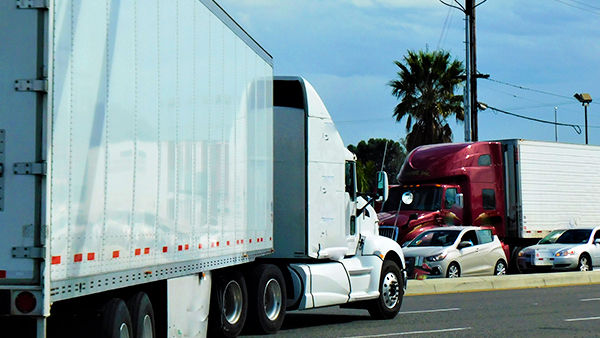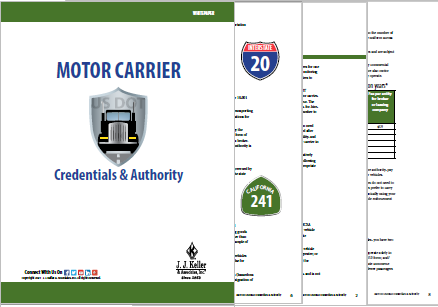The FMCSA regulates motor carriers for one primary purpose: to protect the public. Attempting to determine if you have the necessary FMCSA-required operating credentials can be a daunting task. Download this free whitepaper for more information on what operating authority is needed and when, MCS-150, Unifed Carrier Registration (UCR) and more.
How Are Vehicles Affected by Mergers & Acquisitions?
Corrina Peterson, Transport Editor
September 14, 2022

There is no shortage of advice on how to structure a "deal" to merge two companies into one, create a new subsidiary, or to buy assets. However, when you are looking to merge or acquire another transportation company, there's not nearly as much DOT compliance advice. Managing credentials for the vehicles that come with an acquisition can be particularly fraught with uncertainty.
Vehicle Registration
Every commercial motor vehicle must be licensed, or registered, according to the laws of the jurisdictions in which it operates. Vehicle licensing fees and procedures vary from state to state and can depend upon:
The type of vehicle,
The weight of the vehicle,
Where travel will take place,
The kind of motor carriage being conducted, or
The value or age of the vehicle.
When a vehicle will operate primarily within a single state, a base plate is obtained from that state, depending on the weight and type of vehicle, the registration may authorize travel within the base state only.
All “qualified” vehicles that cross state lines and exceed 26,000 pounds in gross vehicle weight, gross combined weight, or registered gross vehicle weight, and power units with three or more axles must either participate in the International Registration Plan (IRP) or purchase trip permits.
Some states require in state registration or a trip permit at under 26,000 pounds, so vehicles that travel in those states may obtain apportioned plates and participate in IRP as well.
When obtaining vehicles through a merger or acquisition, you can obtain temporary IRP credentials if you already have an existing IRP account with your base state. Otherwise, trip permits will be required.
Fuel Taxes
The International Fuel Tax Agreement (IFTA) is an agreement among member jurisdictions (the lower 48 United States and 10 Canadian provinces) for the collection and distribution of fuel use tax revenues.
IFTA allows carriers (including private carriers) to obtain one license and file one quarterly tax return. The qualified vehicle definition is the same as for IRP.
An IFTA license and decals are company-specific and an IFTA license holder cannot lend those credentials to another company. If the acquiring company already has an IFTA account, you may be able to obtain temporary IFTA credentials. If your state issues temporary decal permits, place a copy of your existing IFTA license in the truck. Use the permit as your IFTA decals for up to 30 days (carry in the vehicle) until you receive the permanent IFTA decals from the state.
Heavy Vehicle Use Tax (HVUT)
The heavy vehicle use tax, or HVUT, is a federal excise tax that helps invest in U.S. transportation infrastructure. Vehicles with a taxable gross weight of 55,000 pounds or more are subject to the tax. It’s a tax that applies to both intrastate and interstate carriers.
The tax period begins on July 1 and ends the following June 30. If you place a new vehicle into service at any point during the year, even through a merger or acquisition, you are required to file and pay the HVUT to take you through the end of the tax year. Returns must be filed by the last day of the month following the month of the vehicle’s first taxable use in the tax period. For example, if you acquired new vehicles in March, you must file and pay the HVUT by the end of April to cover the time through the end of June. You will only pay a proration of the tax.
Unified Carrier Registration (UCR)
Unified Carrier Registration, or UCR, is a fee for interstate carriers to operate. How much you pay is based on the number of interstate vehicles you operate. The only entities not subjected to UCR are purely intrastate carriers that do not handle interstate freight or make any interstate movements, unless the state elects to apply the provisions of the UCR agreement to such intrastate carriers, and private motor carriers transporting passengers in interstate commerce, such as church buses.
The fee is based on the number of vehicles reported on your MCS-150 or the total number of vehicles owned and operated for the 12-month period ending June 30. It is recommended to update your vehicle count on the MCS-150 within 30-days. Doing so will provide a more accurate vehicle count for UCR as well as ensure that a merged operation is fairly compared to other carriers for the Compliance Safety Accountability (CSA) BASICs of Unsafe Driving and Crash.
Properly Marking Acquired Vehicles
There is no grace period in which to properly mark vehicles after a merger or acquisition. The marking regulation requires the following markings to be on both sides of a “self-propelled” CMV (markings are not required on trailers and can be anywhere on both sides of a straight truck):
The carriers full legal name as it appears on the MCS-150
The letters USDOT, followed by
The carrier’s USDOT number.
In lieu of the carriers name, a tradename or “doing business as name” – DBA can be on the vehicle. To do so, the DBA must be included on the MCS-150. This is particularly useful after an asset-only acquisition. The old business name likely has value, and you may want to hold a portion of the business out to the public using the acquired name. Be aware the rules of using a tradename can vary by state (another good place to consult your corporate attorney).
Other Vehicle Specific Programs
Four states have weight/distance fees in addition to IRP, IFTA, and HVUT, the states are Kentucky, Oregon, New Mexico, and New York. The fees, as the name imply, are based on the gross vehicle weight or gross combination weight in combination and the miles operated in the state. The fees and corresponding credentials or permits are vehicle specific.
As with any state, and especially these four, carriers need to know what’s expected regarding recordkeeping and reporting.
Before The Ink Dries
For the most part, vehicles that are part of an acquisition or merger are treated pretty much the same as if you went out and purchased a single new vehicle.
The “deal” can be about anything you can agree on with the other party. Just make sure you are crystal clear on exactly what you’re getting and what your responsibilities are – before and after closing.
The agreement, as the name implies, puts into writing the agreed-to terms. Assume nothing. Typically, if it’s not in the agreement, it’s not agreed upon. Don’t leave things to “well, we talked about that,” or we shook on this.
Before the ink is dry on the signatures, it’s too late to build in any DOT vehicle compliance flexibility.
When you begin the process, keep the end in mind. Have a clear vision of what you hope to accomplish through the merger or acquisition.
J. J. Keller advisors can help you through the entire process of merging or acquiring a transportation company, call 888.473.4638.
FREE Motor Carrier Credentials & Authority Whitepaper & Quote
